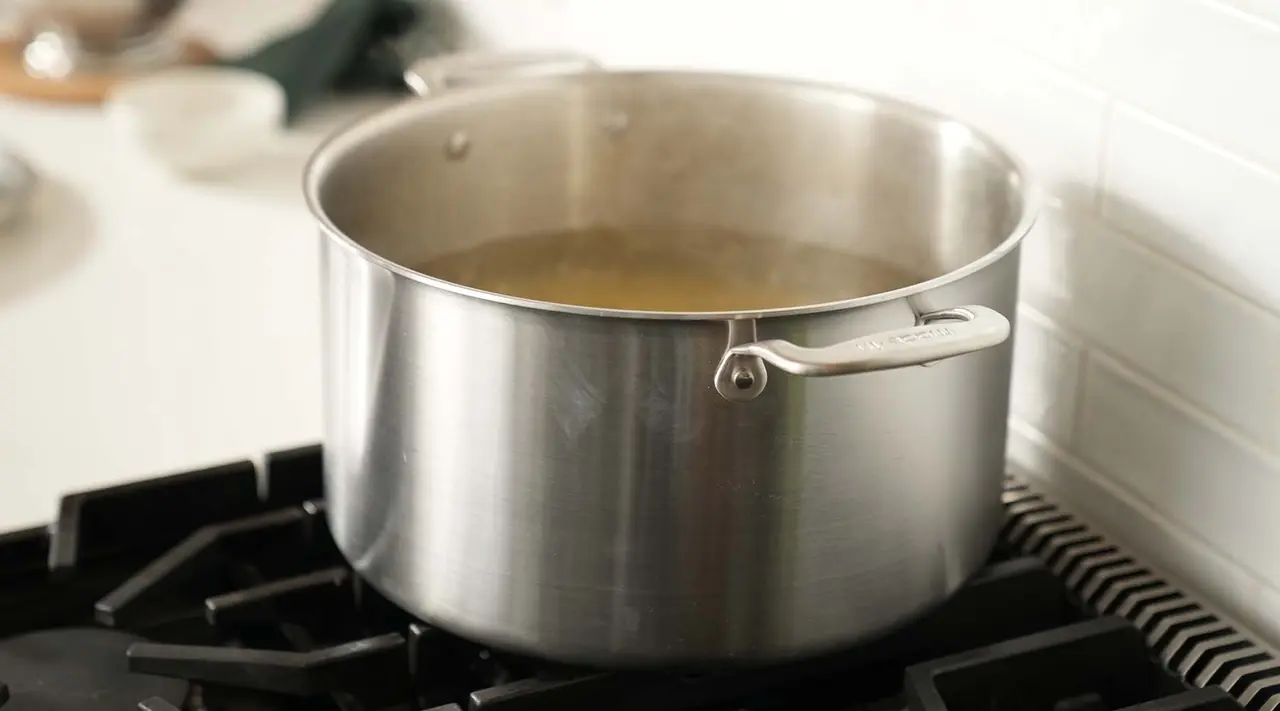Shopping for a Stock Pot doesn’t spark the same level of excitement as, say, a beautiful Copper Rondeau or a razor sharp Santoku Knife does. For some reason or other, Stock Pots feel more utilitarian, less glamorous. Yet their utility makes purchasing the right one all the more important, given you’ll be using it for everything from boiling pasta to making soup.
To help you find the perfect Stock Pot, we’ve put together a buyer’s guide that covers size, construction materials, and every other important design detail to keep in mind.
What Is a Stock Pot?
A Stock Pot is a large, cylindrical piece of Cookware with a circular base, tall straight sides, a tight fitting lid, and two helper handles on either side. Like the name suggests, they’re traditionally used for making stocks and broths, though they can be used for so much more.
Compared to Saucepans, Stock Pots tend to be much larger, slightly heavier, and taller. Their two handles distribute the weight more evenly, whereas a Saucepan has one extended arm to make moving and transporting painless. Our Stock Pot heats quickly and evenly, so that you can simmer soups, stews, broths, and more for long periods of time.
Stock Pot Uses
Because of their capacity and ability to circulate heat evenly, Stock Pots are ideal for making simple stock and broth, or if you’re feeling particularly fancy, cuisson. Their most critical function, however, might be for cooking pasta, in which case you should also be reserving your pasta water to thicken and emulsify your sauce.
Some of their uses are slightly more weather dependent. In the summer, they’re ideal for the seafood boil of your choosing. As weather turns colder, Stock Pots are the foundation for hearty soups and stews.
How to Shop for the Best Stock Pot
When shopping for a Stock Pot, it’s helpful to first take a look at your current Cookware collection and think about what gaps need filling. Beyond that, you’ll want to consider the size that’s most appropriate for your needs, the construction material that will suit you best, how you’ll be using it most, and additional design details.
1. Find the Right Size
Stock Pots come in a variety of sizes, usually denoted by their volume in quarts. The most common sizes for home cooks range from 6 quarts to 12 quarts, and you can almost never go wrong with an 8 quart size. If you tend to cook in larger batches or for a crowd, a 12 quart pot may be a better option.
In addition to the volume, you’ll want to think about dimensions. Stock Pots are, on average, among the largest pieces of Cookware in your kitchen, so you’ll want to make sure the one you’ve chosen will fit both on your stovetop and in your cupboard.
For chefs, Stock Pots come in even more sizes. The largest option we offer (solely to restaurant clients) is a whopping 32 quarts, weighing nearly 14 pounds.
2. Pick the Right Material
Stock Pots come in an array of materials, but by far the best choice is Stainless Clad. It’s lightweight enough to transport large volumes of liquid, heats quickly and evenly (important when trying to bring several quarts of water to a boil), and holds up against denting and warping.
The other popular option is aluminum, which is cheaper and lighter weight, but also more prone to warping, incompatible with induction stovetops, and reactive. Its reactivity makes it unsuitable for cooking anything acidic, which presents additional obstacles.
Other Cookware materials like Copper, Non Stick, and Carbon Steel are less widely available for Stock Pots, primarily because they aren’t necessary. In general, a Stainless Clad option will be the longest lasting and most efficient choice.
3. Think About How You’ll Use it
It’s important to keep in mind what you’ll be using the Stock Pot for and shop accordingly. If you plan on using it for smaller batches of chili or soup, our 8 quart size is ideal. However, if you find yourself hosting large dinner parties, our 12 quart size is better.
4. Take Handles Into Account
Often overlooked in the research and shopping process, handles can make or break a pot. Carrying a heavy, nearly full pot of boiling liquid can be cumbersome at best and dangerous at worst. To prevent burns and spills, making sure your pot has sturdy, balanced handles that evenly distribute the weight and offer a comfortable grip will ensure safe transportation.
Ready to Shop?
When shopping for a new Stock Pot, begin with what you already have in your Cookware lineup and shop from there. Take into account the size that best fits your needs, the construction material that will suit your cooking style and preferences, and other design features that will ensure it can be used safely and comfortably. Whether 8 quart or 12 quart is better for you, we’ve got a Stock Pot that’s perfect.






























